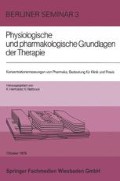Zusammenfassung
Das Phäochromozytom zeichnet sich durch einige markante Besonderheiten aus — insofern als diese Merkmale extreme und gegensätzliche Züge aufweisen:
-
Histologisch benigne (gutartig), aber physiologisch maligne (bösartig).
-
Da ist die Seltenheit der Krankheit: Nur jeder 200. Hypertonie — der häufigsten chronischen Krankheit überhaupt — liegt ein von chromaffinen Zellen abstammender Tumor zugrunde [15].
-
Auf der anderen Seite handelt es sich um eine tödlich verlaufende Krankheit: Eine Art von pharmakologischer Bombe — ( Aranow, 1952 [1]: „a verkable pharmacological bomb“).
-
Die Popularisierung des Krankheitsbildes ist demnach notwendig — Anstrengungen bei der Diagnose wiederum lohnend, weil die operative Entfernung — erfolgt sie rechtzeitig — in den allermeisten Fällen vollständige Heilung erbringt, was man wiederum von 95% aller diastolischen Hypertonien nicht erwarten darf [15]!
-
Durch die erste chirurgische Entfernung eines Phäochromozytomtumors und Heilung der Hypertonie erbrachte Mayo 1927 den Beweis für die blutdrucktreibende Kraft des Tumors [16].
Access this chapter
Tax calculation will be finalised at checkout
Purchases are for personal use only
Preview
Unable to display preview. Download preview PDF.
Literatur
Aranow, H., Jr.: Pheochromocytoma. In: Bean, W. B., ed., Monographs in Medicine. Series 1. Baltimore, Williams and Wilkins (1952) pp. 179-224.
Axelrod, J.: O-Methylation of epinephrine and other catechols in vitro and in vivo. Science 126, 400–401 (1957).
Cordes, U., Georgi, M., Günther, R., Beyer, J.: Adrenale und extraadrenale Phäochromozytome. Dtsch. med. Wschr. 104, 317–323 (1979).
Crout, J. R., Sjoerdsma, A.: Catecholamines in the localization of pheochromocytoma. Circulation 22, 516–525 (1960).
Decourcy, J. L, Decourcy, C. B.: Pheochromocytomas and the General Practitioner. Cincinnati, Barclay Newman (1952).
Dillon, R. S.: Handbook of Endocrinology. Philadelphia, Lea and Febiger (1973).
Euler, U. S. Von, Germzell, C. A., Ström, G., Westman, A.: Report of a case of pheochromocytoma, with special regard to preoperative diagnostic problems. Acta Med. Scand. 153, 127–136 (1955).
Georgi, M., Cordes, U., Günther, R., Philipp, T., Lenner, V.: Phlebographische Diagnostik des Phäochromozytoms. Fortschr. Röntgenstr. 128, 727–733 (1978).
Gitlow, S. E., Mendlowitz, M., Bertani, L. M.: The biochemical techniques for detecting and establishing the presence of a pheochromocytoma. Am. J. Cardiol. 26, 270–279 (1970).
Harrison, T. S., Seaton, J. F., Cerny, J. C., Bookstein, J. J., Bartlett, J. D.: Localization of pheochromocytomata by caval catheterization. Arch. Surg. 95, 339–343 (1967).
Hermann, H., Mornex, R.: Human Tumours secreting catecholamines: Clinical and physiopathological study of the pheochromocytomas. Oxford, New York, Pergamon Press (1964).
Jones, D. H., Allison, D. J., Hamilton, C. A., Reid, J. L.: Selective venous sampling in the diagnosis and localization of pheochromocytoma. Clin. Endocrinol. 10, 179–186 (1979).
Kirkendall, M., Liechty, R. D., Culp, D. A.: Diagnosis and treatment of patients with pheochromocytoma. Arch. Intern. Med. 115, 529–536 (1965).
Kirsten, R., Heintz, B., Hennemann, E., Nelson, K.: Pharmacological approach to the patient with pheochromocytoma. In: Rietbrock, N., Woodcock, B. G., Neuhaus, G., eds., Methods in Clinical Pharmacology. Braunschweig, Vieweg (1980).
Manger, W. M., Gifford, R. W., Jr.: Pheochromocytoma. New York, Heidelberg, Berlin, Springer-Verlag (1977).
Mayo, C. H.: Paroxysmal hypertension with tumor of retroperitoneal nerve. Report of case. J. Am. Med. Assoc. 89, 1047–1050 (1927).
Mühlhoff, G., Pohle, D., Sack, H.: Röntgendiagnostik beim Phäochromozytom unter besonderer Berücksichtigung der Angiographie und ihrer spezifischen Vorbehandlung. Fortschr. Röntgenstr. 119, 286–295 (1973).
Passon, P. G., Peuler, J. D.: A simplified radiometric assay for plasma norepinephrine and epinephrine. Anal. Biochem. 51, 618 (1973).
Pertsemlidis, D., Gitlow, S. E., Siegel, W. C., Kark, A. E.: Pheochromocytoma: 1. Specifity of laboratory diagnostic tests. 2. Safeguards during operative removal. Ann. Surg. 169, 376–385 (1969).
Ross, E. J.: The management of cases of pheochromocytoma. Clinical Staff Conference, University College Hospital, London. Proc. R. Soc. Med. 55, 427–436 (1962).
Rossi, P., Young, I. S., Panke, E. F.: Techniques, usefulness, and hazards of arteriography of pheochromocytoma. A review of 99 cases. J. Am. Med. Assoc. 205, 547–553 (1968).
Sack, H., Koll, J. F.: Das Phäochromozytom. Ergeb. Inn. Med. Kinderheilk. 19, 446–555 (1963).
Vendsalu, A.: Studies on adrenaline and noradrenaline in human plasma. Acta Physiol. Scand. 49 (Suppl. 173): 1–123 (1960).
Wisser, H., Knoll, E.: Die Analytik der Katecholamine und einiger Abbauprodukte im Urin und Plasma. Z. Klin. Chem. Klin. Biochem. 11, 3–14 (1973).
Zelch, J. V., Meaney, T. F., Belhobek, G. H.: Radiological approach to the patient with suspected pheochromocytoma. Radiology 111, 279–284 (1974).
Author information
Authors and Affiliations
Editor information
Rights and permissions
Copyright information
© 1980 Springer Fachmedien Wiesbaden
About this chapter
Cite this chapter
Kirsten, R., Hennemann, H., Heintz, B., Nelson, K. (1980). Methoden zur Lokalisations-Diagnostik von Katecholamin-sezernierenden Tumoren. In: Hierholzer, K., Rietbrock, N. (eds) Konzentrationsmessungen von Pharmaka, Bedeutung für Klinik und Praxis. Vieweg+Teubner Verlag, Wiesbaden. https://doi.org/10.1007/978-3-663-14065-8_5
Download citation
DOI: https://doi.org/10.1007/978-3-663-14065-8_5
Publisher Name: Vieweg+Teubner Verlag, Wiesbaden
Print ISBN: 978-3-528-07904-8
Online ISBN: 978-3-663-14065-8
eBook Packages: Springer Book Archive

